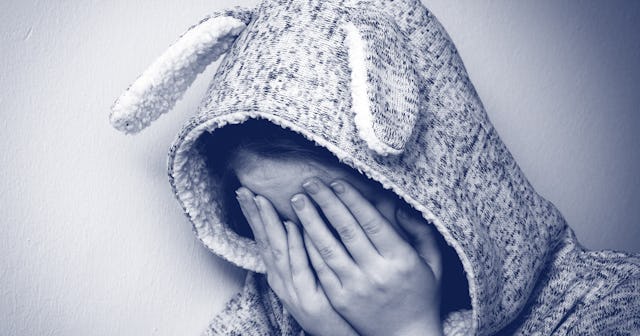After Her 12-Year-Old Attempted Suicide, This Mom Has An Important Message For Parents

Trigger warning: suicide/suicide ideation/self-mutilation
Tweens and teens today eat, live, sleep and breathe school, friends, family and social media. So when any or all of these areas of their life present struggles, it can sometimes make adolescents feel as if their entire world has come tumbling down. And, in a sense, it has.
These people, places, and things are the focus of their life for the time being. How are they supposed to know there is a big wide world waiting for them just beyond the next door when they don’t yet have the key to unlock it? Truth be told, they can’t without parental guidance. And even though mental health issues amongst adolescents are taking thousands each year due to death by suicide, there is still a lack of awareness surrounding the severity of childhood, pre-teen and teenage mental health struggles.
With suicide being the third leading cause of death in those aged 10-24, children’s lives depend on the destigmatization of adolescent mental health, the support of loved ones, and the help of suicide prevention advocates.
One such advocate is Julie Lutz*, a single mother of two whose youngest daughter, Annie Lutz* nearly died by suicide at just 12 years old.
Lutz describes her now-13-year-old daughter as a “beautiful, outgoing, social, caring, ray of shine.” But sometime around November of 2018, Annie’s personality seemed to fade, and Lutz noticed a drastic change in Annie’s mood which she says she attributed to the run-of-the-mill teen angst.
Annie was experiencing difficulties with friends, bullying, issues with her father, and her grandmother’s brain cancer diagnosis. She eventually confided in her mother that she had begun self-mutilation through cutting. The first time Annie practiced self-mutilation, she sought help from her mother out of fear. Later on, Lutz discovered that her daughter had cut herself again. Only this time, she hadn’t sought her mother’s help. As soon as she learned of it, Lutz to seek counseling for Annie right away.
Emiliano Vittoriosi/Unsplash
It seemed to Lutz that Annie was improving with time and counseling, but after what Lutz describes as a “fantastic weekend,” Annie admitted that she’d taken too many over-the-counter-pills while attempting suicide. Those moments are what Julie describes as her “saddest moment ever as a mom.”
“This language of cutting and suicide is not uncommon now,” Lutz tells Scary Mommy. “There’s a lot of layers surrounding [cutting and suicidal thoughts] that we are uncovering.”
Since the attempt, Lutz has been pro-active in supporting her daughter’s mental health by enrolling her in extensive counseling through school and outside of school, as well as installing a security software — Bark — in her daughter’s phone. Bark’s software contains an algorithm designed to notify parents via text and/or email of any potential risks (e.g. suicide, self-harm, sexual-predator “grooming,” drugs, violence, nudity, etc.) detected in a child’s technological devices.
Bark
Technology’s grip on children today is foreign territory to many parents, and this is the first generation raising kids who have had the accessibility of the world wide web at the touch of their fingertips since they were born. Therefore, it’s important for parents to know what is going on inside that universe they hold in the palm of their hands.
While the internet may be a wealth of information when looking for resources about suicide prevention, a research article led by senior lecturer at Bristol Medical School, Lucy Biddle, infers that the internet may influence the appeal of suicide in an already suicidal individual.
Biddle and her team conducted a web search using 12 search terms one might be likely to use when looking for suicide methods. They focused on analyzing the first 10 sites listed, with research conducted for a total of 240 valid searches. Biddle’s results showed that roughly half of the sites were pro-suicide sites or chat rooms while the other half were suicide prevention pages.
The scariest part? The three most commonly occurring sites across all searches were all pro-suicide.
When Lutz downloaded Bark, she was notified nearly 100 times a day, mostly for bullying and profanity. Two months after her daughter’s suicide attempt, Bark notified Lutz that her daughter had been browsing and searching for pills around the house with the purpose of self-harm.
Lutz tells Scary Mommy, “Nothing could have prepared me for this.”
After Annie’s search was flagged and reported to Lutz, Bark sent a “Love Box” with a heartfelt card, beautiful art and checked in later to see how Annie and the rest of the family were doing.
This road may not be easy for Lutz, Annie or the rest of their family, but through intense counseling, loving interventions, boundaries with negative peers, and maintaining a safe and open environment, Annie is continuing to find better ways to manage her mental health and stress.
Now, Lutz is advocating for those who are suicidal, as well as raising awareness for parents who may or may not know their children are having suicidal thoughts or tendencies. The Internet and social media follow us everywhere, but this technology is seeking to monitor the safety of that accessibility.
Lutz’s recommendation: “Monitor your kid’s technology. [It’s] so important.”
*Names have been changed for minor’s sake.